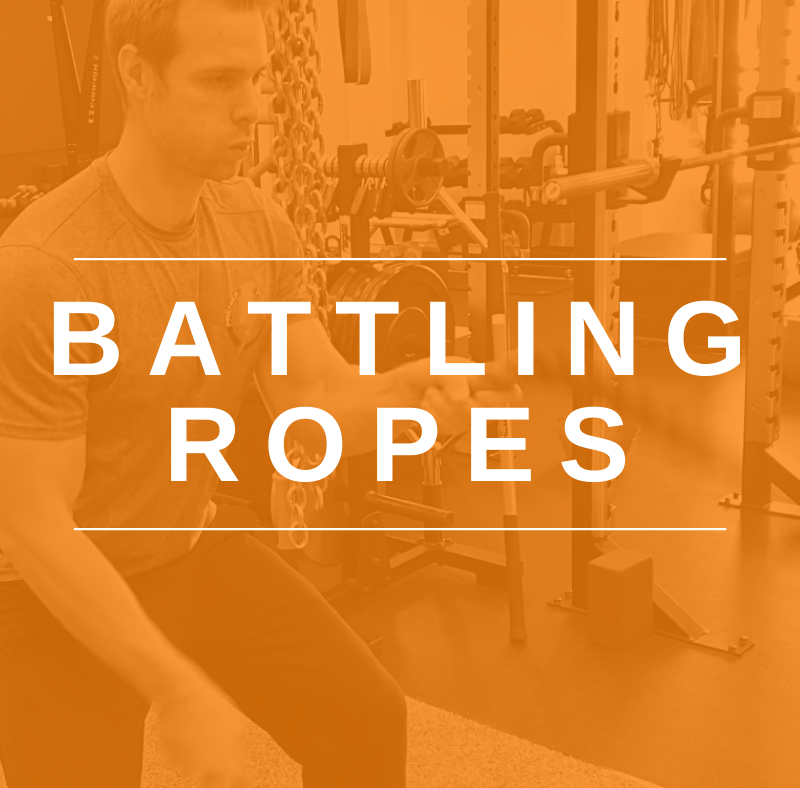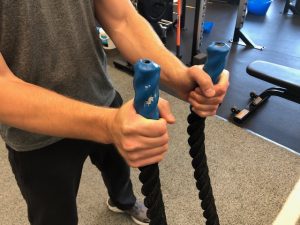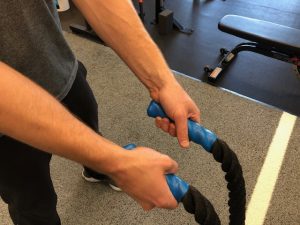
There are certain pieces of equipment that have been around for a long time such as ellipticals and treadmills but over the last 10 years, we’ve seen more creative and “functional” equipment hit the fitness scene like battling ropes. Battling ropes have emerged and become more common in strength and conditioning facilities as well as gyms and private training studios. Certainly traditional cardio equipment will always have their place in the gym, however the anaerobic component and variety in exercises available using battling ropes is the antedote to the monotony of long duration cardio sessions. All you need is 15 seconds per set to get the burn.
Benefits of Battling Ropes Workouts
- Improves cardiovascular health
- Increases the E.P.O.C. response (Excess Post-Oxygen Consumption)
- Works the entire body
- Strengthens grip
- It’s just fun and keeps workouts fresh versus doing mindless/long bouts of cardio
Learn more in our Functional Training Specialist as a part of our Continuing Education Course Series.

Setup and Execution
Start off with a little bit of slack in the rope. Get into a shoulder-width stance (for most exercises) in an athletic or ready position. When performing the exercises, be sure to stabilize your torso –which means try to prevent the back from moving or twisting.
Types of Battling Rope Grips
There are two types of grips using ropes, there is overhand (thumbs down) and handshake (thumbs up)


Key Points to Consider
- The longer or thinker the rope the more challenging it is compared to shorter or thinner ropes. Most common ropes are 40 feet with 1.5 to 2 inch diameters for bigger ropes and 30 feet with 1 to 1.5 inch diameter for smaller ropes.
- Don’t let the ropes pull you forward, instead keep your weight back in hips and heels planted.
- Stay tall through the spine and keep your core braced. Torso stabilization is key with ropes, your core has to resist motion making it work harder while preventing injury to your lower back.
- Be sure to anchor the ropes properly and securely
Execution
The exercise begins by making “waves” with the ropes. This is initiated by lifting the arms up and down explosively all while maintaining your position so your core and legs work to resist motion created by upper body. You can also do circular movements with the arms or whips that all work the arms differently. It’s the combination of strength to lift the ropes and power to keep the ropes moving quickly.
Most Common Battling Rope Exercises
-
Bilateral waves
-
Alternating waves
-
Circle waves
-
Jumping Jack waves
Programming
The best time to throw the ropes into a workout is at the end. You don’t want to take energy and stamina away from the main compound strength exercises such as chin-ups, squats, deadlifts, and presses. Use the ropes as a finisher as the final burn. If you are truly giving your best effort, you wont need to do anthing else to complete your workout. Aim for 4-6 sets of 15 to 20 seconds per set of max effort intensity and rest for the same amount of time giving the work to rest ratio 1:1.
Final Thoughts
Ropes are fun and challenging for all levels. If you have never tried them you are missing out! When it comes to exercise we all can find ourselves getting in a rut from time to time so keep it fresh by throwing in battling ropes. Give your arms a great burn while making the rest of the body work by holding position. Get all the heart health benefits without spending most of your time doing endless cardio.






